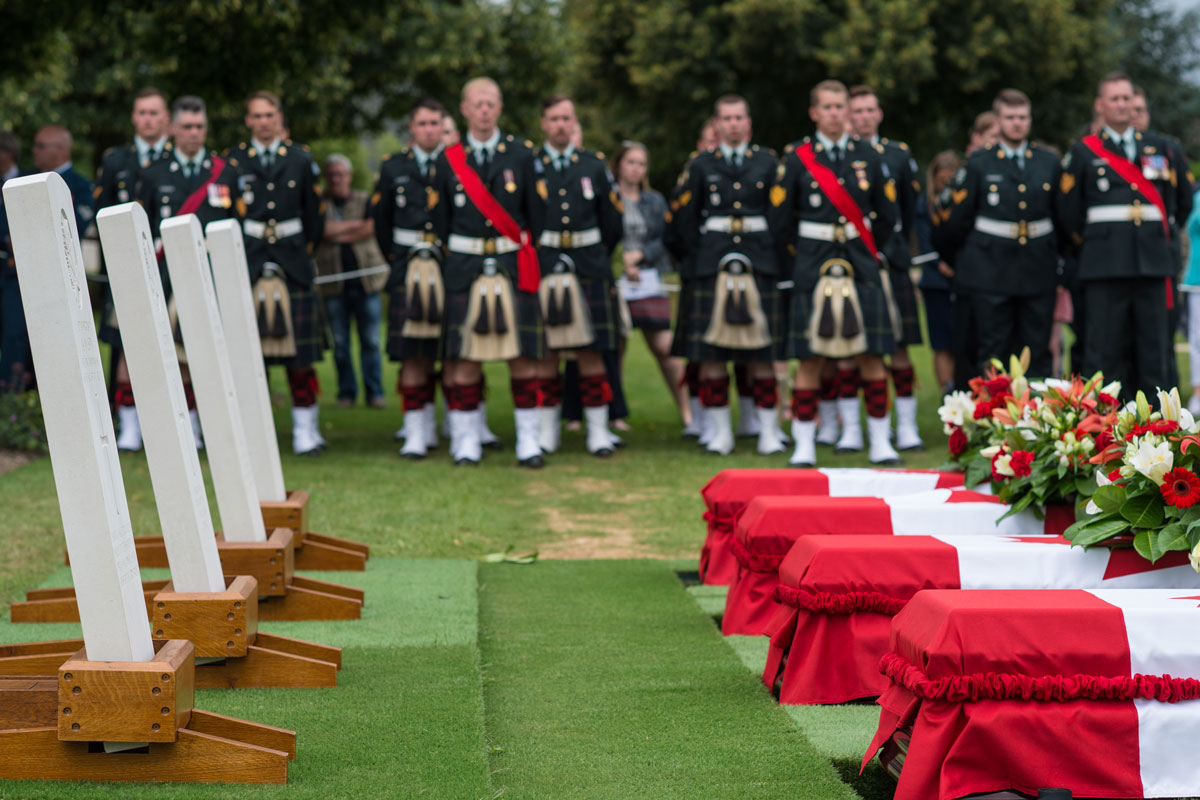Canadian Scottish Regiment honour their fallen
By Lookout on Sep 07, 2018 with Comments 0

Soldiers from the Canadian Scottish Regiment of Victoria and the Royal New Brunswick Regiment of Fredericton stand at ease alongside the final resting place of four Canadian First World War soldiers who died at the Battle of Hill 70. Photos by MCpl True-dee McCarthy, CF Combat Camera
Peter Mallett, Staff Writer ~
Personnel from The Canadian Scottish Regiment (Princess Mary’s) have returned from a burial service in France honouring three of its members killed in battle over a century ago.
Three burial parties of eight soldiers each from the Victoria regiment and one burial party representing the Royal New Brunswick Regiment of Fredericton, N.B. participated in the service at the Commonwealth War Graves Commission’s (CWGC) Loos British Cemetery near Lens, France on Aug. 23. They were honouring four Canadian soldiers who died during the First World War’s Battle of Hill 70. The battle lasted for 11 days in August 1917.
The successful identification of the four soldiers was recently announced in May 2018 by the Department of National Defence (DND) and Canadian Armed Forces’ (CAF) Casualty Identification Program. The identities of the soldiers were confirmed through historical, genealogical, anthropological, archeological research and, DNA analysis. The Casualty Identification Program aims to identify the remains of newly discovered Canadian soldiers killed-in-action prior to 1970, so they can be buried with their name by their regiment and in the presence of their families.
The remains of Private William Del Donegan, 20, Private Henry Edmonds Priddle, 33, and Sergeant Archibald Wilson, 25, were found near the village of Vendin-le-Vieil, France, and identified by DND and the CAF on May 22, 2018. All three soldiers enlisted in Winnipeg, Manitoba, as members of the 16th Canadian Infantry Battalion (The Canadian Scottish), Canadian Expeditionary Force (CEF), a unit perpetuated by The Canadian Scottish Regiment (Princess Mary’s) of Victoria. The remains were discovered during a munitions clearing process between September 2010 and August 2011.
The identification of the remains of a fourth Canadian soldier was announced on May 28 as Private John (Jack) Henry Thomas, of the 26th Canadian Infantry Battalion (New Brunswick), a unit perpetuated by The Royal New Brunswick Regiment of Fredericton, N.B.. His remains had been found at the site of a construction project in Lens in 2016.
Representatives from all four soldiers’ families were in attendance with support from Veterans Affairs Canada. Members of each family laid a wreath at the foot of their loved one’s grave as the ceremony concluded.
Heartfelt Moments
Their caskets were draped in Canadian flags and the service included the Ode to Remembrance, the Last Post, and the customary moment of silence, allowing those attending to reflect on the cost of war.
Chaplain, Captain Kenneth Nettleton of the Canadian Scottish Regiment presided over the service and emphasized the historical importance of the moment and the thousands of First World War headstones located across France.
“These stones are sacred stones, these stones mark the lives of people that left their homes and unlike [crossing] the River of Jordan they crossed an ocean,” said Capt Nettleton. “They came to this land and gave their lives for the freedom of France and the Western world, the world that we know and love today.”
Those sentiments were not lost on Lieutenant Patrick Rippon, an Infantry Officer of the Canadian Scottish Regiment. Lt Rippon commanded the funeral party and says there were many emotional moments for himself and the rest of his regiment during their week-long trip to France; especially the tours of military graves. But during the burial service he remained professional.
“During the ceremony my main focus was providing the fallen with as much dignity as possible,” said Lt Rippon. “I was focused on the job, and the emotional weight of what I was doing was not at the forefront of my mind.”
His final duty was to bring military artifacts, including shovels, buttons and, canteen cups found with the remains of Sgt Wilson, Pte Priddle and Pte Donegan, back to Canada. He will present the artifacts to his unit, which will then be placed in the Canadian Scottish Regiment museum at the Bay Street Armory.
Approximately 1,300 of the 2,100 Canadian soldiers who gave their lives in the Battle of Hill 70 have no known graves. The battle raged from Aug. 15 to 25, 1917, and was the first major action fought by the Canadian Corps under a Canadian Commander. Hill 70 remained in allied hands until the end of the war.
Filed Under: Top Stories
About the Author:





